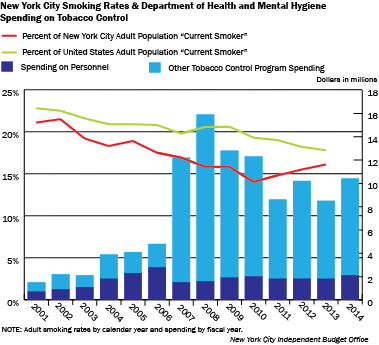In 2009, the city’s Department of Cultural Affairs concluded a multiyear initiative to reform the Cultural Development Fund, the primary source of city funding for hundreds of arts and cultural organizations throughout the five boroughs. (The 33 cultural institutions located on city-owned property receive other support and are ineligible for these grants.) From fiscal years 2009 through 2015, the city has awarded a total of $210.5 million in Cultural Development Fund grants. An average of 886 organizations per year received funding.
- Total annual Cultural Development Fund grants (including City Council member items and Borough Arts Council grants) have increased from $29.0 million in fiscal year 2009 to $33.2 million in 2015. There is $33.5 million budgeted for the fund in 2016. Average funding per organization increased from $32,858 in 2009 to $37,340 in 2015.
- Groups based in Manhattan receive by far the most funding, with awards totaling just under $20 million in 2015; organizations in Brooklyn, the borough with the second-highest share, received $6.5 million in funding that same year.
- Manhattan’s share of total funding has decreased somewhat, from 63.7 percent in 2009 to 60.1 percent in 2015, while Brooklyn’s share has increased from 15.7 percent to 19.5 percent over the same time span. Shares for the other three boroughs changed very little.
- Average funding per organization in 2015 ranged from $29,079 in Staten Island to $59,224 in the Bronx.
Organizations receiving grants can focus on single disciplines such as folk art, dance, or literature or be multidisciplinary. Multidiscipline organizations have received the highest percentage of total funding, over one-quarter of all funding each year. There has been little change in the distribution of funding across all disciplines since the revamping of the cultural fund in 2009.
NOTES: *Chart excludes funding for Borough Arts Councils because many of them do not categorize recipient groups’ disciplines. **Combines Botanical, Crafts, New Media, Photography, Science, and Other categories. ***Combines three different multidiscipline categories.
- Music has seen the biggest decrease in its share of funding over the past seven years, a drop of 2.9 percentage points from 17.0 percent of total funding in 2009 to 14.1 percent in 2015.
- Visual arts has seen the biggest increase in its share of funding over the same time period, from 4.5 percent in 2009 to 6.4 percent in 2015.
Prepared by Katie Hanna
New York City Independent Budget Office
SOURCE: Department of Cultural Affairs
Print version available here.
